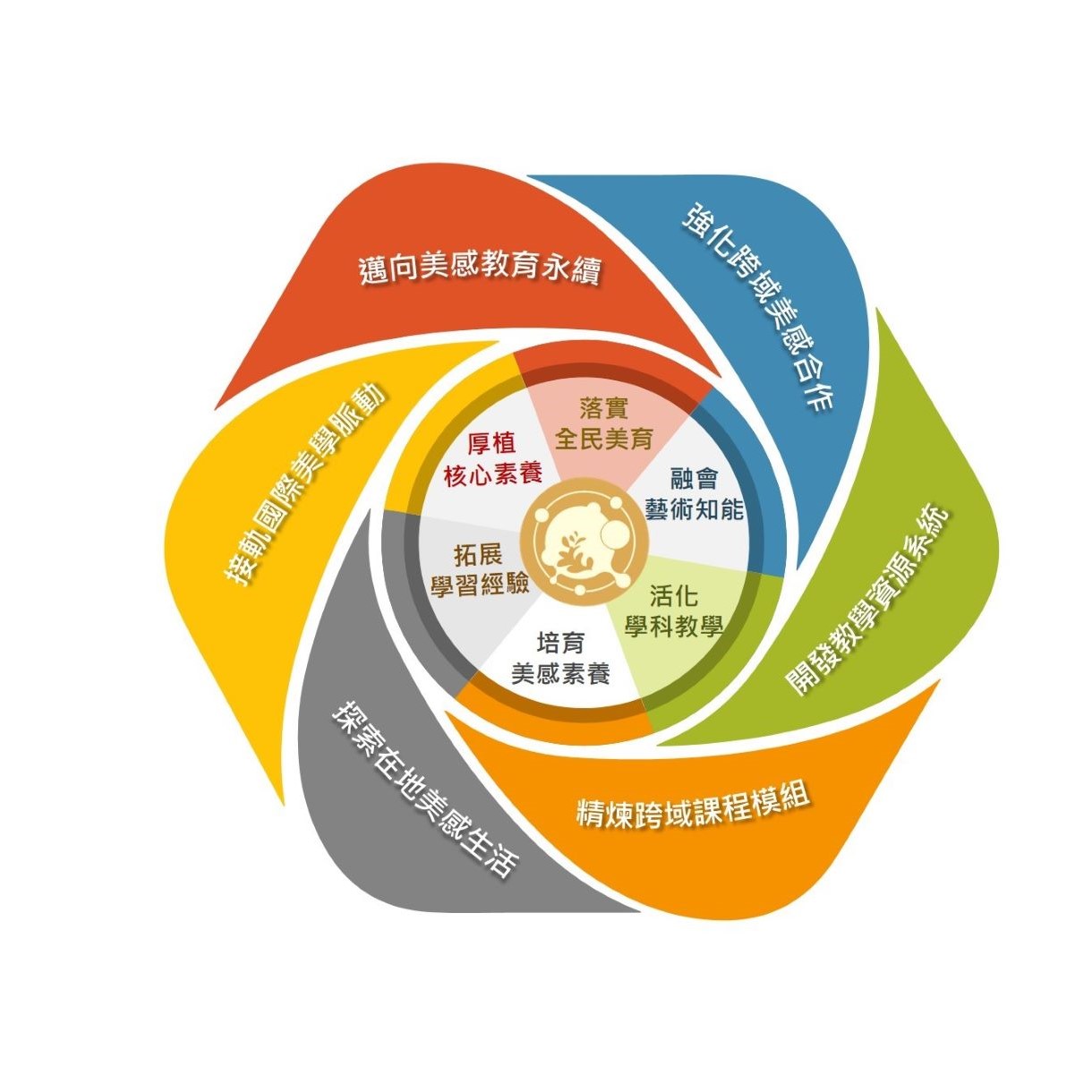1. Planning concept
This plan has entered the "diffusion" stage since 113. It is based on the implementation results of the first four phases and takes the 12-year National Basic Education Implementation Outline as the premise to develop the vision of this phase, strengthen cross-domain aesthetic cooperation, and develop a teaching resource system. , refining cross-domain course modules, exploring local aesthetic life, and connecting with the pulse of international aesthetics. It is hoped that through the six major visions, students will obtain a more comprehensive and innovative art and subject learning process through an aesthetic experience that integrates the five senses and six senses.

Vision of cross-disciplinary aesthetic education program
2. Plan Goals
In order to continue the course that has been developed organically since 2014, the planning team hopes to continue to deepen the core concepts of cross-field aesthetic education on the existing basis, comprehensively integrate the development results of the first four phases, and formulate the six major plans of this phase. The development goals are as follows.
- Refining and deepening the cross-domain aesthetics course module, and continuing to develop diverse cross-domain aesthetics courses such as SDGs, issue integration, and SEL, to popularize cross-domain aesthetics teaching to all fields and learning stages.
- In response to the international trend of bilingual education and digital learning, examples of bilingual cross-domain aesthetic courses are added, and the planning website and course teaching resources are integrated and activated to expand the application scope of aesthetic education resources.
- Cooperate with public and private departments and institutions such as industry, government, and academia, integrate aesthetic education resources, and jointly improve teachers’ aesthetic literacy and cross-domain curriculum design knowledge.
- Organize a national diverse cross-domain aesthetic teacher professional community to create and practice courses in a "big hand holding small hand" approach, and conduct curriculum collaboration and promotion through cross-regional exchange mechanisms to sustainably cultivate cross-domain aesthetic education in Taiwan.
- Select cross-domain aesthetics cooperative schools to expand the number of professional communities/groups of cross-domain aesthetics teachers year by year, and encourage partner universities to offer courses related to cross-domain aesthetics to strengthen the cultivation of cross-domain aesthetics teacher talents.
- Organize training visits for foreign teachers, investigate the latest international teaching trends, enrich the international perspective of participating teachers, and promote exchanges in aesthetic education at home and abroad.
3. Implementation Policy

(1) Refining diversified cross-domain course modules
Compiled and summarized the cross-domain aesthetic course materials and data of this project over the years, combined with the feedback from teachers at the teaching site, conducted cross-research and analysis, and integrated it into the 12-year National Basic Education 108 curriculum concept, SDGs and issues. A cross-field aesthetic course module is refined that conforms to the learning trends in today's society. In addition, based on this course module, we have developed a series of model cross-field aesthetic courses in seven major subject areas. At the same time, we have compiled a series of teaching guide manuals in conjunction with the model courses, filmed and produced teaching guide videos, and gradually developed different learning stages and different styles in a step-by-step manner. A series of cross-domain aesthetic course application textbooks in subject areas allow teachers in seed schools to use systematic teaching resources and cooperate with teacher training and university counseling to strengthen diverse cross-domain learning and exploration channels for students participating in the courses, and jointly create more Comprehensive and rich courses.
(2) Strengthen the sustainable development of aesthetic courses
From the perspective of resource integration, we cooperate with county and city tutoring groups, subject centers, private citizens, and enterprises to promote teachers’ aesthetic literacy enhancement research and curriculum collaboration mechanisms, and connect resources related to teaching development in various counties and cities to deepen and broaden aesthetic awareness. Education promotes energy and enriches diverse cross-field aesthetic courses. At the same time, we integrate the resources of senior cooperative schools in cross-domain aesthetics to promote aesthetics courses. Through cross-regional and cross-learning stage class exchanges/promotion workshops, we enhance dialogue and exchanges among interdisciplinary teachers, inherit aesthetics curriculum experience, and expand the cross-disciplinary aesthetics education landscape. .
(3) Develop curriculum digital resource platform
In line with the promotion of the national bilingual education policy, the Convergence Project has covered different learning stages from 1 to 16 over the years. It also connects diverse fields such as science, Chinese, mathematics, life, etc., and even integrates rich cross-domain aesthetic curriculum resources to allow current teachers and teachers in the field to Through the assistance and promotion of the planned bilingual teaching resource platform, the trainees can combine the cross-domain preparation with English teachers to mutually enrich the field majors and language teaching majors, and achieve bilingual aesthetic learning with bilingual teaching majors in both the existing field teaching majors and the bilingual teaching majors. Classroom, thereby allowing students to develop the habit of independent bilingual use in experiential learning opportunities with more life connections.
(4) Promote cross-domain community collaboration network
Comprehensive review of the promotion of cross-field aesthetic education in counties and cities over the years, it can be seen that the consensus on aesthetic education among counties and cities still needs to be improved. In order to reduce the differences in the effectiveness of promoting aesthetic education among counties and cities, a community collaboration network model will be used to connect central and local aesthetic education. The curriculum teaching coaching network affects and drives primary and secondary school teachers in different regions and with different expertise across the country, helping them acquire cross-field aesthetic curriculum and teaching knowledge. Through teachers' cross-border exchanges, experience sharing and empowering cooperation, we can open up teachers' curriculum design experience, enhance teachers' professional capabilities and recognition, and then transform the cross-field aesthetic education goals into physical courses, and at the same time enhance participation in cross-field aesthetic education Plan cooperative schools, teacher and student coverage rate.
The Cross-Disciplinary Aesthetic
Cross-disciplinary aesthetic project
The Cross-Disciplinary Aesthetic Education Program
